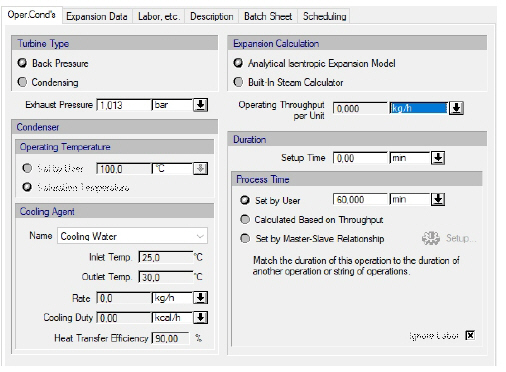

The following table shows a brief description of the variables appearing in this tab. The table also displays their default values and their generally acceptable range. Note that due to how the variables are used in the modeling equations, the range of acceptable values may be further reduced; for more details, see Power Generation in a Steam Turbine-Generator: Modeling Assumptions & Constraints.
|
Variable |
Default Value |
Range |
|
|
||
|
○ Exhaust Pressure (atm) |
1.0 |
Positive |
|
◙ Operating Temperature of Condenser (oC) |
100.0 |
Positive |
|
○ Cooling Agent Name |
<Cooling Water> |
Any Cooling Agent |
|
● Inlet Temp. (oC) |
25.0 |
Positive |
|
● Outlet Temp. (oC) |
30.0 |
Positive |
|
● Rate (kg/h) |
0.0 |
Positive |
|
● Cooling Duty (kcal/h) |
0.0 |
Positive |
|
○ Heat Transfer Efficiency |
90.0 |
0-100 |
|
● Operating Throughput per Unit |
0.0 |
Positive |
|
○ Setup Time |
0.0 |
Positive |
|
◙ Process Time (min) |
60.0 |
Positive |
|
○ Ignore Labor? |
Yes |
Yes/No |
Symbol Key: ○ User-specified value (always input); ● Calculated value (always output); ◙ Sometimes input, sometimes output
The following list describes the available specification choices in this tab; for more details on how these are implemented, see Power Generation in a Steam Turbine-Generator: Modeling Calculations.
•Turbine Type...
If a back pressure turbine is selected, the specified exhaust pressure must be greater than or equal to ambient pressure.
If a condensing turbine is selected, the specified exhaust pressure may be less than the ambient pressure.
•Expansion Calculation...
By default, the isentropic work is calculated analytically (“Analytical Isentropic Expansion Model” option). Optionally, if the working fluid is steam, the user may choose to calculate the isentropic work based on steam enthalpies before and after the expansion, calculated based on a built-in steam calculator (“Built-In Steam Calculator” option).
•Operating Temperature of Condenser...
If the operating temperature is set by the user, the user may specify a value that is less than or equal to the saturation temperature of the working fluid at the specified exhaust pressure.
If the operating temperature is set equal to the saturation temperature, the operating temperature will be calculated by the program so that it matches the saturation temperature of the working fluid at the specified exhaust pressure. If the “Built-In Steam Calculator” option is selected, the saturation temperature of steam at the specified exhaust pressure is calculated based on the built-in steam calculator.
•Duration Options...
In Rating Mode, you can set the process time (and the setup time), allow the process time to be calculated (based on the throughput and rating power of the units), or allow the duration to match exactly the duration of another operation either in the same procedure or in another procedure. In Design mode, you must either specify the process time (and the setup time) or allow the duration to match exactly the duration of another operation (either in the same procedure or in another procedure) in order for the program to calculate the required power (per step and per unit).
a) If you choose to match the duration of this operation with the duration of another operation,
b) You introduce a master-slave relationship between the two operations. The program will match the setup-time, the process time and the turnaround time of this compressing operation (the 'slave') with the corresponding times of the reference operation (the 'master' operation). For more on master-slave relationship, see The Scheduling Tab.